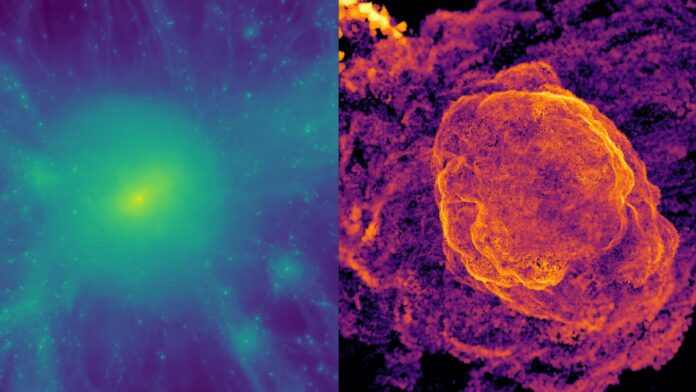For decades, astronomers have been puzzled by the existence of faint, gigantic structures in space known as “radio relics.” These ghostly arcs, stretching for millions of light-years across galaxy clusters, are remnants of violent collisions between these cosmic behemoths. Now, new high-resolution simulations from the Leibniz Institute for Astrophysics Potsdam (AIP) in Germany finally appear to crack the code behind their peculiar behavior.
The Mystery of Radio Relics
Radio relics are formed when shock waves from colliding galaxy clusters accelerate electrons to near-light speed, emitting diffuse radio waves. These structures are common, but observations have revealed inconsistencies that defied existing theoretical models: stronger-than-expected magnetic fields, varying shock strengths measured in radio versus X-ray light, and even shocks that appeared too weak to accelerate electrons at all.
Why this matters: Galaxy cluster collisions are among the most energetic events in the universe, shaping the evolution of galaxies within them. Understanding how relics form reveals fundamental processes at work when structures collide on cosmological scales.
A Multi-Scale Simulation Breakthrough
The AIP team’s breakthrough came from using simulations that spanned multiple scales. They first modeled the collisions of galaxy clusters over billions of years, then zoomed in on the physics of individual shock waves interacting with the turbulent outskirts of these clusters. This approach allowed them to reproduce observed relic features with unprecedented accuracy.
Key Findings: Amplified Magnetic Fields
The simulations show that magnetic fields in relics aren’t just strengthened by the initial shock wave but are further amplified when the shock collides with other shocks created by falling cosmic web gas. This collision compresses plasma into dense sheets, generating turbulence that twists and compresses magnetic fields far beyond what a single shock could achieve.
Discrepancies Resolved: Radio vs. X-Ray Measurements
The team also explained why radio and X-ray measurements of shock strength differ. The simulations revealed that shocks sweep across dense gas clumps, creating localized regions of intense acceleration. These compact patches dominate the radio signal, while X-ray telescopes measure the average shock strength, including weaker regions, accounting for the discrepancies.
The Role of Turbulence
The simulations also show that the shock waves don’t just accelerate electrons evenly. Turbulence plays a crucial role, twisting and compressing magnetic fields to observed strengths. This turbulence is created by the shock waves colliding with each other, creating a cosmic maelstrom.
“The whole mechanism generates turbulence, twisting and compressing the magnetic field up to the observed strengths, thereby solving the first puzzle,” said Christoph Pfrommer of AIP.
The Future of Relic Research
The AIP team’s success opens new avenues for studying these enigmatic structures. By combining large-scale cosmological simulations with high-resolution shock-tube models, they’ve overcome a major hurdle in understanding the physics of galaxy cluster collisions. Future research will likely build on this work to unravel the remaining mysteries surrounding radio relics, providing deeper insights into the universe’s largest and most energetic events.
The simulations confirm that the strongest, localized parts of the shock front produce most of the radio emission. The low average strengths inferred from X-rays pose no threat to the underlying physics after all.






























